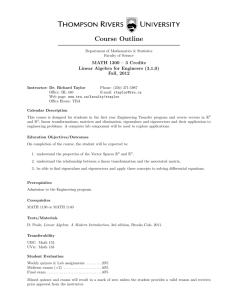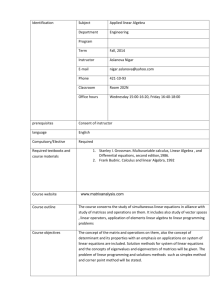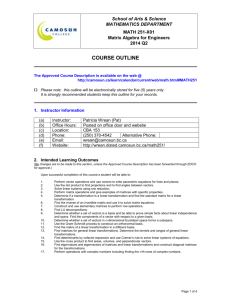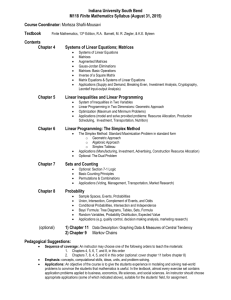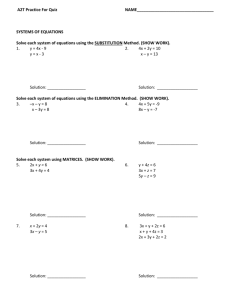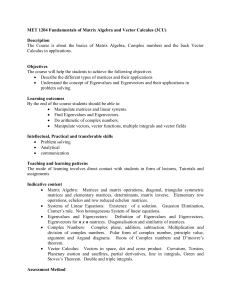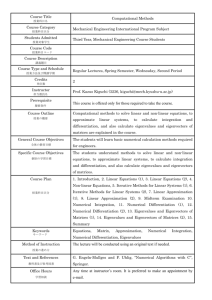MA 511 ASSIGNMENT SHEET Spring(!) 2010 Text: G. Strang Linear
advertisement
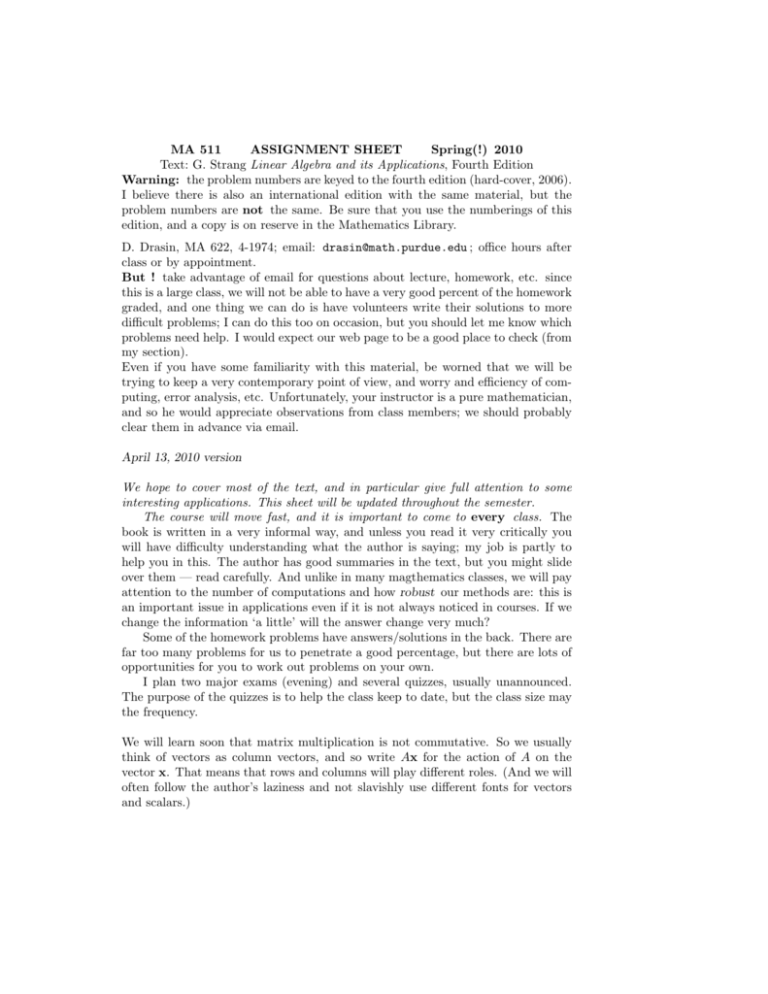
MA 511
ASSIGNMENT SHEET
Spring(!) 2010
Text: G. Strang Linear Algebra and its Applications, Fourth Edition
Warning: the problem numbers are keyed to the fourth edition (hard-cover, 2006).
I believe there is also an international edition with the same material, but the
problem numbers are not the same. Be sure that you use the numberings of this
edition, and a copy is on reserve in the Mathematics Library.
D. Drasin, MA 622, 4-1974; email: drasin@math.purdue.edu ; office hours after
class or by appointment.
But ! take advantage of email for questions about lecture, homework, etc. since
this is a large class, we will not be able to have a very good percent of the homework
graded, and one thing we can do is have volunteers write their solutions to more
difficult problems; I can do this too on occasion, but you should let me know which
problems need help. I would expect our web page to be a good place to check (from
my section).
Even if you have some familiarity with this material, be worned that we will be
trying to keep a very contemporary point of view, and worry and efficiency of computing, error analysis, etc. Unfortunately, your instructor is a pure mathematician,
and so he would appreciate observations from class members; we should probably
clear them in advance via email.
April 13, 2010 version
We hope to cover most of the text, and in particular give full attention to some
interesting applications. This sheet will be updated throughout the semester.
The course will move fast, and it is important to come to every class. The
book is written in a very informal way, and unless you read it very critically you
will have difficulty understanding what the author is saying; my job is partly to
help you in this. The author has good summaries in the text, but you might slide
over them — read carefully. And unlike in many magthematics classes, we will pay
attention to the number of computations and how robust our methods are: this is
an important issue in applications even if it is not always noticed in courses. If we
change the information ‘a little’ will the answer change very much?
Some of the homework problems have answers/solutions in the back. There are
far too many problems for us to penetrate a good percentage, but there are lots of
opportunities for you to work out problems on your own.
I plan two major exams (evening) and several quizzes, usually unannounced.
The purpose of the quizzes is to help the class keep to date, but the class size may
the frequency.
We will learn soon that matrix multiplication is not commutative. So we usually
think of vectors as column vectors, and so write Ax for the action of A on the
vector x. That means that rows and columns will play different roles. (And we will
often follow the author’s laziness and not slavishly use different fonts for vectors
and scalars.)
1.1-1.3 Systems of Linear Equations. (1/12 ) This introduces the basic framework and reinforces the value of a geometric viewpoint, as well as simply computing.
This will also show ho we must be careful in formulating statements. How do we
‘count’ equations? Is the system 2x = 3, 4x = 6 one or two equations? How do we
tell? How about 2x = 3, 4x = 7?
From high school we ‘know’ that n ‘linear’ equations in n unknowns ‘has’ one
and only one solution, but in fact this is not always true — it depends on how
you count! We view such a system as either n linear equations with real numbers
unknown or as a single equation in n-dimensional vectors; obviously the second
way will be easier as we encounter more cumbersome situations (but many things
depend on huge numbers of variables!). We introduce Gaussian elimination and
address the efficiency of this algorithm. Later we will learn about the rank of a
matrix and augmented matrix, and this is how we ‘count’ the number of equations
in a system.
Problems: p. 9: 2, 3, 4, 5; p. 15: 6, 11, 18.
1.4 Matrices and their algebra. (1/14 ) Matrices are an efficient may to express
systems of equations in a way to which humans can relate. Elementary matrices
give an algebraic way to view Gaussian elimination. Problems: p. 26: 2, 3(a), 7,
20, 24
1.5 Triangular factorization. (1/19) Decomposition A = LU or (more symmetrically) A = LDU (p. 36) if no row exchanges are necessary. Otherwise, need
to apply principle to P A instead of A, where P is a permutation matrix, and
P −1 = P T . Problems: p. 39: 1, 5, 6, 8, 13, 21
1.6 Inverses, symmetric matrices. (1/19) Problems: p. 52: 5, 6, 11 (a, b), 13
, 25, 30
1.7 Certain applications, large simple matrices, conditioning. (1/21) Problems: added 1/20: No homeowrk for section 1.7.
Review: p. 65: 12, 19, 22, 26a,b
2.1 Vector spaces (subspaces). (1/26) Closed under + and scalar multiplication. This is where you should be clear on the definition: some strange objects can
be vector spaces. Contrast subspace and subset. Two important subspaces arise
in solving systems of linear equations: the nullspace and the column space; be sure
that you can make clear sentences about solving linear equations in terms of these
(sub)spaces. Problems: p. 73: 2, 3, 7 (a, b, c), 11, 15
2.2 Ax = b in the general case.({bf 1/27} although initiated 1/26) Echelon,
row(-reduced) echelon form, pivot and free variables. Note procedures outlined informally on pp. 80 and 83. Problems: p. 85: 2, 4, 6, 11.
2.3 Linear independence, spanning set, basis, dimension. (1/28) Another way
to count vectors. Problems: p. 98: 1, 6, 14, 18, 19, 20, 24, 35, 38
2.4 Fundamental (sub)spaces of an (m × n) matrix A. (2/2) • This is a little
complicated to keep in mind!. This important section connects many of the
ideas we have introduced. Column space (dim r), nullspace (dim n − r), row space
(sol space of AT ), left nullspace (nullspace of AT ). (The first two are in Rm ; the
other two in Rn .) These are related to the echelon forms U and (reduced echelon)
R of A. The fundamental theorem of linear algebra is on p. 106. We learn about
left/right inverses. Problems: p. 110: 3, 4, 7, 11, 21, 27; p. 137: 2, 5, 11
2.6 Linear Transformations. (2/4) Definition: T (cx + dy) = cT (x) + dT (y).
Examples come from matrix
R x algebra and also from ‘function spaces,’ operations
such as f → f 0 , f → 0 f (t) dt. Determined by action on a basis (however,
(x + y)2 6= x2 + y 2 !). Special matrices: P (projection), Q (rotation), H (reflection).
On pages 128,129 we find how to associate a matrix to a linear transformation T .
Is there only one matric for each transformation? How about for the important
example T p = p0 for p ∈ P4 ? Problems: p. 133: 4, 6, 7; p. 137: 29, 31.
3.1 Lengths, Angles, Orthogonality (2/9) Orthogonal complements. Fundamental theorem of orthogonality (p. 144). Reinterpret fundamental theorem of
linear algebra. Problems: p. 148: 2, 3, 11, 14, 19.
3.2 Cosine! (2/11)is more important than sin . Projection onto a subspace
(high-school math helps here). Projection: P 2 = P . Note: sometimes I write (x, y)
instead of xy T (which the book uses). Problems: p. 157: 3, 5, 10, 12, 17.
3.3 Least squares. (2/16, 2/18) Find ‘best’ solution to Ax = b with b confined
to a subspace S. If e(⊂ S) is this solution so that e = Ax̂, then e is perpendicular
to S. The number of applications of this section is a course in itself, we just skim
the surface. Notice how the formula P = A(AT A)−1 AT is the only way we can
write the formula from the previous section–there A was a column vector a, now it
is an m × n matrix, with m > n. Warning: The author usually requires that the
columns of A be independent, that is when the matrix AT A has an inverse.
The important formulas are on p. 162–note the distinction between the best
estimate x̂ = (AT A)−1 b and the projection, which is Ax̂. Problems: p. 170: 3,
4 (think about why calculus is relevant here!), 22, 23, 31; also 7, 14, 17, 18, 27
(these are due 2/23).
3.4 Orthogonal matrices and bases. (start 2/18) (Book notes that ‘orthonormal’ matrix would be a better term.) If Q is orthogonal and square! then
Q−1 = QT . Q is reserved for matrices with orthonormal columns . If
Q is square, every vector may be written as a linear combination ofP
the columns
(or rows!) of Q, and we get a formula for the coefficients: if x =
xj qj , then
xj = qjT x, where qj is the jth row of Q.
If Q is not square (so it will ’ ! have to ! have more rows than columns), then
we want the best (least-squares) solution to Qx = b. The Gram–Schmidt process
transforms any linearly independent set of vectors into an equivalent (what do we
mean by that?) set of othonormal vectors. Problems: p. 185: 1, 3, 6, 11, 14.
3.40 (2/23 ) Now factor a matrix A as A = QR; Q is orthogonal and R is
right-triangular (not quite the U we had in Chapter 1), and R is invertible. See the
formula (12) on p. 181:
T
T
T
q1 q1T b q1cc
q2 b q2 = QR.
A = a b c = q1 q2 q3
q3T c
We apply these ideas to vector spaces of functions and see that expanding a
function in a Fourier series is just the Gramm-Schmidt process. (Don’t be terrified
by this, it just uses the formulas we’ve been developing.) Best linear fit for data.
Problems: p. 187, 16, 21, 25, 29, 31.
End of Chapter 3 for us unless there is strong desire to use FFT .
4.1 -4.3 Determinants (3/25 for24.1; the other on 3/2). We follow the text
and define the deerminant of an n × n matrix A, det(A) or |A|, as a function of
A which is 1 for the identity matrix, changes sign when two rows are interchanged
(this is a special kind of permutation called a transposition), and is linear with
respect to operations on the first row. Of course, this has many consequences,
which are points 3–10 in §4.1 of the book. Be a little careful (!), since sometimes
people learn a formula for the 3 × 3 determinant which doesn’t work when n > 3.
We derive several formulas for |A|, including the one with cofactors. In principle,
det(A) involves nn sums, but we see quickly that there are really only n! sums
(which is far less than nn ).
Problems :Note: only §§4.1, 4.2 dues 3/2 p. 206: 5, 8, 15, 17(c), 28, 29; p.
215: 5, 6, 9 (a, b), 12 (challenging).
4.4 Applications of determinants (3/4). Formula for A−1 (not computationally
efficient), Cramer’s rule. Determinants and volumes. We answer the question
directly now: when does A factor: A = LU ?
Problems: 3, 5, 10, 14, 15, 28.
End of Chapter 4
Review: Exam March 10 (evening)
5.1 Introduction to eigenvalues. (3/11) Instead of Ax = 0, we now ask: when
does the equation Ax = λx (where λ is a scalar) have a nontrivial solution (so that
x 6= 0). This comes up in systems of equations, and we quickly find that for most λ
there is only the trivial solution. The x for which this euqation has a solution are
called eignevectors , and our goal is to find, as best as possible, a basis consisting
only of eigenvectors (why is this a good idea?). The trace and determinant of A
are expressed in terms of the eigenvalues of A. Does a nontrivial rotation have any
eigenvectors?
Problems: p. 240: 3, 4, 7, , 11, 14, 25, 26 [which is why we will be introducing
complesx number fairly soon], 30.
5.2 Best case: diagonalization. If there are n linearly independent eigenvectors,
then A can be diagonalized with respect to a basis consisting of eigenvectors.
The matrix S with eigenvactors as columns is said to effect a similarity . Eigenvectors corresponding to different eigenvalues are linearly independent.
Problems: p. 250: 4, 5, 12, 17, 24 29, 30.
5.4 eA and stability. If we can diagonalize A = SΛS −1 , then du/dt = Au has
the solution u(t) = eAt u(0), and this is very easy to compute. The solutions are
stable if <λi < 0 for all i, and unstable when at least one has positive real part.
We show how a linear equation of higher order may be written as a first-order
linear system.
Problems: p. 275: 1, 3, 7, 14 [use material at bottom of p. 273 as model], 21,
22, 36.
5.5 Complex matrices. (due 4/6 ) Material to p. 282 bottom is routine. New
vocabulary: Hermetian, unitary matrix (analogues of symmetric and othrogonal
matrices). Good dictionary on p. 288. The famous spectral theorem is introduced
in an offhand manner on p. 285.
Problems: 7, 8(!), 11, 14, 20.
Appendix B (Jordan form). Here we sketch what happens when the matrix A
cannot be diagonalized; the Jordan form is the best we can do.
Problems: p. 427: 1(b), 6, 7.
5.6 Similarity as a subject in itself. (Probs fhrough 15 due 4/6 )We think
of a similarity matrix as expressing a change of basis (usually made so that a linear
transformation is simpler to understand with respect to a different basis). We
can always transform a matirx A by a unitary similarity U −1 AU to be triangular
(what happens if A is Hermetian??). Spectral theorem formally stated on p. 297.
Examples for Jordan form. p. 298: Normal matrices defined: these are exactly the
matrices with a full set of orthonormal eignevectors.
Problems: p. 302: 3, 5, 8, 9, 12, 15, 18, 20, 24, 35 [also find eJ ], 38, 41.
3.5 FFT Very efficient, one of the most quoted papers on the last century.
Problems: p. 196: 1, 3, 7, 11, 15, 18, 21 [don’t try this if not comfortable].
Positive Definite Matrics. Saddle points.
6.1 (review of MA 261!, can be done via quadratic formula.) Consider the
quadratic form xT Ax – is it always positive? Can it change signs?? This is the
second term of a Taylor series.
Problems. p. 316: 3, 4, 7, 9, 15, 20.
6.2 Tests for P. D. (4/13)
Problems. p. 326: 1, 4, 7, 10, 17, 29
6.3: This is omitted in Spring 2010 ‘[a] great matrix factorization.’ Any matrix
A may be factored as A = U ΣV T where the outside factors are square. The columns
of U, V come from eigenvalues of AAT , AT A. we touch upon some applications.
Problems. 1, 2, 6, 8, 10, 14.
6.4 Minimum principles. Most of this only is for positive definite matrices. We
get the formula for least squares (see p. 162)
x̂ = (AT A)−1 AT b
in another manner. We also consider the Rayliegh quotient
xT AX
,
xT x
which is easy to analyse with respect to an orthogonal basis (which is always possible!).
Problems. 1, 2, 4 these are due 4/15), 5, 7, 11a.
7.2 Matrix norm, sensitivity. 4/15) We define the ‘norm’ of the matrix A as
kAk = max |Ax|,
where the maximum is over vectors x of length 1. This can be written other ways.
It is easy to compute for p. d. matrices; in general we replace a not-necessarily=p. d. matrix A by AT A or AAT , but must remember to take square roots. The
condition number of a p. d. matrix is
c = kAkkA−1 k
, and we have that max λ/ min λ. This is important for computation: If in the
equation Ax = b we replace either b by δb or A by δA, then the errors (respectively)
x + δx or δx of the solutions are controlled by this number c (p. 355).
Problems. p. 357: 1, 5, 6, 11a, 12 bc, 13 a.
